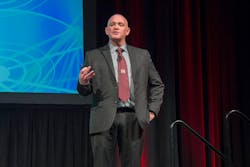FHWorld18: Response Efforts at the Las Vegas Shooting
Oct. 1, 2017. Thousands of concert-goers are watching country music singer Jason Aldean perform at the Route 91 Harvest Festival when gunfire erupts. People begin fleeing in all directions, with hundreds being struck by bullets being fired from the 32nd floor of the Mandalay Bay Resort & Casino. Calls flood 9-1-1. As people flee, spreading out all over the Las Vegas strip and into other areas of the city, people begin seeing the walking wounded, setting off a chain reaction of additional 9-1-1 calls reporting shootings at other locations. There was a perception by some that the entire city was under attack.
This was the situation faced by Clark County, NV, Fire Department (CCFD) Fire Chief Greg Cassell, Las Vegas Metropolitan Police Department (LVMPD) Undersheriff Kevin McMahill and countless other first responders who descended on an unfathomable scene.
During the Firehouse World exclusive Extra-Alarm Session “Horror on the Las Vegas Strip,” Cassell and McMahill described the response to the event, which ultimately left 58 people dead and 851 injured, making it the deadliest mass shooting committed by an individual in the United States. They also shared several lessons that the agencies learned from the event and identified those areas where they are still looking to improve.
Motive and planning
McMahill immediately addressed one of the most unnerving aspects of the event—the shooter’s motive—acknowledging that it’s still unknown: “Without a doubt, none of us expected to go up to that room and find a 64-year-old white male,” he said. “He’s vanilla at best.”
McMahill detailed the shooter’s basic biographical information, including the fact that he was borderline genius, had no criminal past and had paid off his casino debts: “There’s nothing we can point to show that he was pissed off at the police. Who pays off their debt before they kill 58 people? I can’t figure it out.”
Describing the shooter as a “gun nut” who purchased top-of-the-line products, McMahill added that the investigation determined that the shooter had performed online searches for things like how to be the most famous mass murderer in America. But he didn’t leave a suicide manifesto or similar clues as to his motive.
McMahill said that while ISIS has claimed responsibility for the shooting, investigators don’t see any evidence of radicalization of this nature. “It doesn’t matter if we don’t prove [that he wasn’t radicalized by ISIS],” he said. “What does matter is that ISIS is telling its members to duplicate this style of attack in as many places as possible … there’s an opportunity for this person to inspire others to do this type of attack again.”
Several crime scene photos highlighted the lengths to which the shooter planned the attack. The shooter had disabled an emergency exit on his hotel floor and set up monitoring cameras and a remote air supply, possibly to protect himself from the gases resulting from the rapid-firing weapons or perhaps from law enforcement tactics like tear gas.
After breaching the shooter’s suite at the Mandalay Bay, not only did law enforcement find the shooter dead from a self-inflicted gunshot wound, but they also discovered an arsenal of weapons, including 14 AR15s with bump stocks, eight AR10s, a Smith & Wesson air weight .38 revolver, approximately 1,050 spent rifle rounds, numerous ammo magazines, and a bolt action .308 rifle. The shooter used the .308 rifle in an attempt to blow up jet fuel tanks at McCarran International Airport. Two bullets did strike the tanks, and one penetrated a tank, but the jet fuel did not ignite.
“He watched one too many Bruce Willis movies, thinking he could blow up those fuel tanks,” Cassell said.
Response efforts
On duty at the festival that night were 51 LVMPD personnel, 16 personnel associated with community ambulances, one person from Department of Building and Fire Prevention, and zero fire department personnel. Cassell said that going forward, anytime there is an event with more than 15,000 people, the fire department will be there in a unified command with other agencies.
“It’s one of our lessons learned,” he said, adding that there were dozens of off-duty fire department, EMS, military and medical personnel who exemplified “heroism at its best,” as they jumped into action when the shooting started.
There were more than 800 patients, with 422 people shot. More than 250 patients were transported by EMS, and other people were taken to hospitals in personal vehicles. A major issue was simply getting inbound crews to specific locations. There were so many victims that responding units would stop to help gunshot victims, not making it to their assigned areas.
The fire response ultimately included 15 engine companies, three truck companies, 26 rescues (two-person ALS ambulance), one squad (one-person ALS unit), seven battalion chiefs, two EMS supervisors, one mass-casualty incident (MCI) unit, one air resource/rehab unit, 11 chief officers, and 161 valley-wide fire department personnel. There were four dispatchers working at the start of the incident, as well as 10 communications specialists and one senior communications specialist, with more than 780 incoming and outgoing calls handled.
Responders faced several unique challenges, including issues with victim egress. The venue itself was 17.5 acres in size, but the scene quickly expanded to a 3.5-square-mile area as people and victims fled the area. Some were so desperate that they actually breached double razor-wire fences or tore down security gates at the adjacent airport, with some people even making it into airport hangars.
Interagency relationships
McMahill emphasized the importance of interagency relationships in handling complex events of this nature. “It’s all about relationships,” he said. “I can’t overstate that enough. I know all the jokes about police and fire … but there are a lot of things that we should learn from each other because we are true partners when the shit hits the fan.”
It wasn’t always this way, though. McMahill explained that following the 2008 Mumbai, India, terror attack, members of the LVMPD traveled to Mumbai to study the event, with the overall goal of developing a plan for Las Vegas. The trip was the catalyst for the creation of MACTAC—Multiple Assault Counter-Terrorism Action Capabilities.
“One of the things that happened was realizing that this wasn’t entirely a police problem,” he said, so they reached out to local fire departments to get ideas and help with integrating services. And in 2012, the CCFD placed a captain in the Southern Nevada Counter-Terrorism Center (SNCTC), also known as a Fusion Center. “This began this incredible relationship among all levels of our organizations because they saw that the people at the top gave a shit and wanted to get things done,” he added.
As part of MACTAC, LVMPD teaches basic law enforcement/fire department integration in CCFD’s academy; CCFD does the same for LVMPD. CCFD also teaches ICS in the LVMPD academy, and CCFD is involved in LVMPD’s sergeant and lieutenant training. McMahill acknowledged that it took a year and a half of effort, including working through some bad drills, but they ultimately developed the Southern Nevada Fire Operations Hostile MCI Plan for use in events.
Additionally, Cassell described the use of Rescue Task Forces (RTFs) the night of the shooting—and the preparation that led to their deployment. Specifically, thousands of police officers and firefighters had trained on for the deployment of RTFs at historic-type events involving a unified command, defined warm zones and known victims.
“Never in a million years did we think we’d deploy 19 RTFs,” Cassell noted. But they were ready, and the relationships formed between police and fire paid off.
Getting help
“PTSD—we have to talk about it,” Cassell stressed. “I’m living it; [McMahill’s] living it.”
Cassell explained that CCFD called everyone into mandatory peer support after the event. Personnel were praised and thanked for their efforts at the shooting, and advised to go home, rest, stay off the phones and avoid the media. Personnel were provided information related to employee assistance programs (EAPs) and behavioral health organization (BHO) services, with peer support teams and BHO representatives present.
Additionally, the International Association of Fire Fighters (IAFF) sent two teams of crisis counselors who met with all IAFF-represented departments in the area. The IAFF team members took the BHO provider list and vetted each provider to ensure that the best providers were available to meet with first responders. They also met with CCFD responders and their families for several hours.
“It was an absolute godsend for us as an organization,” Cassell said.
Recognizing that peer support teams (PSTs) will continue to surface over the next few years, CCFD has recruited more members to bolster PSTs numbers, arranged for additional training for PST members, and is monitoring its PST personnel to ensure they too are doing OK after the event.
Cassell underscored that the single most important thing learned from the event was the need for a Family Assistance Center (FAC). “Thank god for the city of Orlando and the city of San Bernardino,” he said, explaining that these cities—which have each faced mass shootings—offered invaluable help in this area.
McMahill reiterated this point, saying that it is vital that departments go back to their jurisdictions to figure out how they will handle this critical element of a major incident. So many departments, he said, don’t realize the expansive nature of the work provided through these centers. FACs help with family reunification, provide crisis counseling, work with the coroner’s office for notifications to next of kin, assist with hotels and transportation for family members coming to the location, set up childcare, help with applications for victims benefits and compensation, advise on legal issues, and even helping with returning personal effects, like cell phones.
“We have a responsibility to take care of our people,” McMahill stressed, adding that getting help with the FAC took so much off the plates of first responders, freeing them up to focus on their primary duties.
Lessons reinforced
Cassell said they are revisiting their policies related to the Southern Nevada Fire Operations Hostile MCI Plan. Specifically, the plan currently states that RTFs cannot deploy unless there are three things in place: 1) unified command, 2) known victims and 3) a designated warm zone. In the shooting, it was not possible to have a warm zone, but they still needed to deploy the RTFs, hence the need to consider some “broader strokes” with the plan.
With hospitals overrun with victims, and nursing staff are not able to perform some of the functions needed for some trauma patients, Cassell said they are working on a plan to tie-in engine companies with hospitals so medics are available to perform medical functions on patients arriving by personal vehicle.
Additional lessons learned noted by Cassell:
- Get the fire department more involved in special events planning.
- Include dispatch centers and private ambulance providers in future ICS/table-top exercises.
- Conduct additional training between fire and police departments on expanded ICS events.
- Keep incident command post clear of those who don’t need to be there.
- Address staging issues related to not being able to get personnel to assigned locations.
- Shield members from the media.
- Develop or enhance EAPs.
- Identify resources in the community that can help.
- Address communications issues, as the system was overloaded.
- Figure out a plan for managing multiple radio channels.
- Consider having a cache of trauma-related supplies on hand at each event.
Cassell and McMahill reiterated the importance of training and working together, as you never know when your jurisdiction will face an unthinkable tragedy of this nature.
“This event shocked our entire organization, still to this day,” Cassell said.
About the Author

Janelle Foskett
Janelle Foskett served as editorial director of Firehouse Magazine and Firehouse.com, overseeing the editorial operations for the print edition along with working closely with the Web team.
